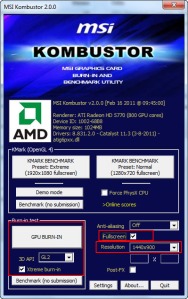How to stress test your GPU – Test Your Graphic Card for Stability
Stress Testing a Graphic Card – GPU Stress Testing
Stress testing or torture testing your overclocked GPU is extremely important to ensure it runs stable all the time. If you have just started overclocking by increasing the clocks in increments, a 10 minute test is sufficient so that you can try pushing you graphic card more. If you have already reached the wall, do a test for 2 hours. In continuation with my previous blog post on GPU Overclocking, where I explained how to overclock your graphic card, I’m going to discuss how to stress test a GPU to ensure stability.
How to make sure your overclock is stable
To stress test your graphic card, you need the following tools.
Stress testing a GPU is really easy. Fire up MSI Kombustor.
- Select Fullscreen
- Select your resolution
- Under Burn-in test, select Xtreme burn-in
- Select GPU BURN-IN
This will invoke a furry object on screen which actually does the stressing. Let it run for 2 hours (just 10 minute is enough if you have just started to find the max overclock by increasing the core/shader in small increments at a time). But you have to closely monitor the temperature as this test will produce unrealistic load on the GPU and as a result, the core temperature will skyrocket. Increasing the fan speed to 80% or even more is recommended before running Kombustor.
Observe the furry object carefully for any artifacts. Anything other than the furry object is an artifact. If your GPU is stable, everything will be fine; otherwise, you may see graphic artifacts on screen or your system may even crash or become unresponsive. In that case, you will only have to hard reboot your system. This is an indication of a too much overclock and you will have to reduce a few MHz (of core/shader/memory).
I’m not able post a screenshot of graphic artifacts because my system simply becomes unresponsive or throws BSOD when my GPU becomes unstable.
Things to Keep in Mind Before Stress Testing Your GPU
I can’t stress this enough. You may have to find the maximum safe temperature of your GPU by doing a Google search. Once you get to know that, you have to make sure the core temperature doesn’t exceed that. You can keep the temperature in check by increasing the GPU fan speed using MSI Afterburner and by installing more fans on your PC cabinet. If possible, you can also get a third-party GPU cooler.
Ensure that you have a good power supply (PSU). Cheap ones are not recommended even if you don’t intend to overclock anything. Stress testing a graphic card will really pull lots of power and your PSU must be able to provide the required power with as little ripple as possible. Get a good PSU from Corsair, Seasonic etc. Cooler Master is okay but be wary of the fact that the Extreme Power series PSUs are notorious for blowing up under load, yet I see a lot of people still use them as they are cheaper.
If you live in a hotter area, switch on the air conditioner. If the ambient is below 23, you have greater chance of hitting even more MHz.


” Thanks for that awesome posting. It saved MUCH time 🙂
Nice to be here, I absolutely like your site. So much helpful facts. Thanks much for sharing this with us. Adios for now!